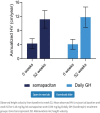Long acting growth hormone (LAGH), an update
- PMID: 37842029
- PMCID: PMC10569466
- DOI: 10.3389/fped.2023.1254231
Long acting growth hormone (LAGH), an update
Abstract
In 1957, Maurice Raben at Yale was able to isolate and purify growth hormone from cadaveric pituitary glands. Pituitary growth hormone was the only way to treat children with growth hormone (GH) deficiency, until 1985 when recombinant GH became available for daily subcutaneous injection. For many years, the pediatric endocrine community longed for a long-acting recombinant GH formulation that would decrease the inconvenience of daily injections. Several mechanisms were employed to develop a GH that is rapidly absorbed into the blood stream after subcutaneous injection, but provides slow removal from the circulatory system to potentially optimize patient adherence to GH therapy. Four long-acting growth hormones are currently available in the world, or are close to regulatory approval. They are: (1) Pegylated formulations, (2) Prodrug formulations which are converted into active drug, (3) Nonvalent transient albumin binding GH compounds and (4) GH fusion proteins where a protein si fused with GH. All four formulations have undergone detailed phase 3 studies and were found to show non-inferiority in these clinical studies. All four demonstrate a safety and tolerability profile that is comparable to that of daily somatropin with an excellent adherence profile.
Keywords: fusion proteins; growth hormone; growth hormone deficiency; long acting growth hormone; pegylation.
© 2023 Grillo, Frank and Saenger.
Conflict of interest statement
The authors declare that the research was conducted in the absence of any commercial or financial relationships that could be construed as a potential conflict of interest.
Figures



Similar articles
-
Long-acting growth hormone in 2022.Pediatr Investig. 2023 Jan 3;7(1):36-42. doi: 10.1002/ped4.12358. eCollection 2023 Mar. Pediatr Investig. 2023. PMID: 36967745 Free PMC article. Review.
-
Long-acting recombinant human growth hormone in the treatment of pediatric growth hormone deficiency, how far have we got?Arch Pediatr. 2022 Feb;28(8S1):8S14-8S20. doi: 10.1016/S0929-693X(22)00038-0. Arch Pediatr. 2022. PMID: 37870528
-
Long-acting growth hormone in the treatment of children with growth hormone deficiency.Expert Rev Endocrinol Metab. 2025 May;20(3):169-186. doi: 10.1080/17446651.2025.2486067. Epub 2025 Mar 31. Expert Rev Endocrinol Metab. 2025. PMID: 40159984 Review.
-
Usefulness and Potential Pitfalls of Long-Acting Growth Hormone Analogs.Front Endocrinol (Lausanne). 2021 Feb 24;12:637209. doi: 10.3389/fendo.2021.637209. eCollection 2021. Front Endocrinol (Lausanne). 2021. PMID: 33716988 Free PMC article. Review.
-
Spotlight on Lonapegsomatropin Once-Weekly Injection and Its Potential in the Treatment of Growth Hormone Deficiency in Pediatric Patients.Drug Des Devel Ther. 2022 Jun 29;16:2055-2066. doi: 10.2147/DDDT.S336285. eCollection 2022. Drug Des Devel Ther. 2022. PMID: 35791404 Free PMC article. Review.
Cited by
-
Long-acting growth hormones: innovations in treatment and guidance on patient selection in pediatric growth hormone deficiency.Ann Pediatr Endocrinol Metab. 2025 Apr;30(2):106-110. doi: 10.6065/apem.2448202.101. Epub 2025 Jan 15. Ann Pediatr Endocrinol Metab. 2025. PMID: 39810511 Free PMC article.
-
Comparative Efficacy of Once-Weekly Somatrogon Versus Daily Growth Hormone Therapy in Children With Idiopathic Growth Hormone Deficiency: A Real-World Retrospective Study From Greece.Cureus. 2025 Apr 25;17(4):e82998. doi: 10.7759/cureus.82998. eCollection 2025 Apr. Cureus. 2025. PMID: 40416193 Free PMC article.
-
A Novel Y-Shaped Pegylated Recombinant Human Growth Hormone for Children With Growth Hormone Deficiency.J Clin Endocrinol Metab. 2025 Jul 15;110(8):e2605-e2613. doi: 10.1210/clinem/dgae816. J Clin Endocrinol Metab. 2025. PMID: 39607675 Free PMC article. Clinical Trial.
-
Human growth hormone therapy - in three stages: past, present, and future.Pediatr Endocrinol Diabetes Metab. 2024;30(2):49-50. doi: 10.5114/pedm.2024.140935. Pediatr Endocrinol Diabetes Metab. 2024. PMID: 39026480 Free PMC article. No abstract available.
-
Somapacitan in Children Born SGA: 52-Week Efficacy, Safety, and IGF-I Response Results From the Phase 2 REAL5 Study.J Clin Endocrinol Metab. 2025 Mar 17;110(4):1086-1095. doi: 10.1210/clinem/dgae616. J Clin Endocrinol Metab. 2025. PMID: 39271158 Free PMC article. Clinical Trial.
References
-
- Mejia-Corletto J, Saenger PH. Long-acting growth hormone: an update. In: Cappa M, Cianferani S, Ghizzoni L, Lockhe S, Maghnie M, editors. Advanced therapies in pediatric endocrinology and diabetology. Vol. 30. Endocrin Dev, Basel Karger; (2016). p. 79–97. - PubMed
Publication types
LinkOut - more resources
Full Text Sources

